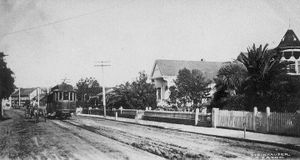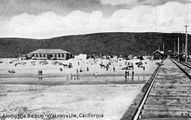Difference between revisions of "Watsonville Transportation Company"
| Line 54: | Line 54: | ||
Boxcar - 4<br /> | Boxcar - 4<br /> | ||
Flatcar - 16<br /> | Flatcar - 16<br /> | ||
===Newspaper Clippings=== | ===Newspaper Clippings=== | ||
Latest revision as of 12:55, 18 November 2020
California / Transit / Watsonville Transportation Company
History
By Andrew Brandon
The Watsonville Transportation Company began as the result of the local farmers resentment towards Claus Spreckles' after the closure of the Western Beet Sugar Co. plant in Watsonville. Closure of the plant forced local farmers to send their crop for processing in the town of Spreckles via the Pajaro Valley Consolidated Railroad. The other option being to send their product by the Southern Pacific at higher rates. Among locals there was great support in a potential alternative to those options. This fervor caught the attention of San Jose business promoters W. J. Rogers and H. H. Main. Combined with the three men from Watsonville ( Robert W. Eaton, F. A. Kilburn and Stephen Schurich), they began planning and working with locals to develop a system suited to their needs.
On February 13, 1903, the five incorporated the Watsonville Transportation Company to connect the city of Watsonville to Monterey Bay with addtional steamship service to San Francisco. During planning, numerious sites were considered for the location of the new port along the coast. Unfortunately, the preferred locations around Moss Landing had already been taken. The Pajaro Valley Consolidated had an existing pier, and the coastline north of Moss Landing as far as Camp Goodall was owned by the Pacific Coast Steamship Co. The nearest available location was a site exposed to open sea named Port Rogers after W.J. Rogers. From here the steam schooner "F. A. Kilburn" would provide service to San Francisco. the local farmers had succeeded in bypassing the Southern Pacific, Pajaro Valley Consoldiated, and Pacific Coast Steamship Co. altogether!
The line opened to much fanfare on April 16th, 1904, quickly becoming a daily part of Watsonville life. Despite the fanfare, the line was plagued with trouble early on. Teredo worms damaged pier almost immediately and by the first fall of operation, major portions of the structure (including 200 feet of the end) required replacement and rebuilding. In November the recently repaired pier was damaged again by heavy storms; this time requiring 500 feet be replaced. Despite these setbacks, the railroad did modest business in competition with the Southern Pacific. Gradually the SP began undercutting the railroad's shipping rate from Watsonville to San Francisco, charging half of the company's $3.00 per ton. With the resulting loss of freight revenue, the Watsonville Transportation Co. shifted focus toward passenger traffic. When the steamer "F.A. Kilburn" was sent to San Francisco for heavy repairs, the line was reduced to hauling recreational passengers from Watsonville to Port Rogers.
A dispute with shareholders over payment of services between Mr. Rogers to Mr. Main lead to the indictment of the two on August 12, 1905. Shortly afterward the Pajaro Valley Bank attached a claim to the company for $19,000. Soon, other creditors pushed claims one by one until the line was driven into bankruptcy. B. F. Brooks was selected as trustee on September 8, 1905, and Fred Linderman as receiver. The Schooner "F. A. Kilburn" was sold and would later burn off the coast of Florida in 1918. The remaining physical plant would remain dormant while Mr. Rogers kept the bankruptcy proceedings in court over the next 6 years. In December of 1907, the railroad was placed in the hands of Edward White, who had been appointed reciever and ordered to dispose of the line. Rogers and Main were eventually cleared of charges due to a lack of evidence In 1911 the line was finally reorganized (without Mr. Rogers involvement) as the Watsonville Railway & Navigation Company.
Bibliography
Fabing, Horace W. and Hamman, Rick. Steinbeck country narrow gauge. Boulder: Pruett Publishing, 1985. ISBN 978-0871086938.
Hilton, George W. (1990). American Narrow Gauge Railroads. Stanford: Stanford University Press. ISBN 0-8047-2369-9.
Fabing, Horace W. "Watsonville Transportation Company", The Western Railroader 29, no. 11 (1966): 1-15.
Reference Material Available Online
Maps
Route of the Watsonville Transportation Co. for Google Earth By Andrew Brandon
Photographs
- Collected Watsonville Transportation Co. Photographs.
Rosters
Reference Data. Incorporated. Febuary 13, 1903
Corporate Ownership. Watsonville Transportation Co. 1904 - 1908
Watsonville Railway & Navigation Co. 1911 - 1913
Distances.
Watsonville Port Rogers - 6 mi
General Office, Power Station and Shops 11 West Third St. Watsonville, Ca
Equipment Totals
Electric Interurban - 4*
Boxcar - 4
Flatcar - 16
Newspaper Clippings
Collected Newspaper Clippings relating to the Watsonville Transportation Co.
Books
Watsonville, Santa Cruz County, California, the Apple and Strawberry Center West of the Missouri River. - Pajaro River Valley Board of Trade. Promotional booklet about farming in the Watsonville area, includes a photograph of the wharf and a description of the railroad.
California / Transit / Watsonville Transportation Company




